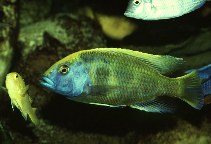GIRAFFE CICHLID
- RM0.00
This product has a minimum quantity of 100
Classification / NamesCommon names | Synonyms | Catalog of Fishes(genus, species) | ITIS | CoL | WoRMS | Cloffa
Actinopteri (ray-finned fishes) > Cichliformes (Cichlids, convict blennies) > Cichlidae (Cichlids) > Pseudocrenilabrinae
Etymology: Nimbochromis: Latin, nimbus = stormy, rainy + Greek, chromis, a fish, perhaps a perch; it has dark clouded melanic blotches on the body (Ref. 45335); venustus: From the Latin "venustus" = beautiful, graceful, elegant (Ref. 55922) More on author: Boulenger.
Etymology: Nimbochromis: Latin, nimbus = stormy, rainy + Greek, chromis, a fish, perhaps a perch; it has dark clouded melanic blotches on the body (Ref. 45335); venustus: From the Latin "venustus" = beautiful, graceful, elegant (Ref. 55922) More on author: Boulenger.
Environment: milieu / climate zone / depth range / distribution rangeEcology
Freshwater; demersal; pH range: 7.2 - 8.8; dH range: 10 - 18; non-migratory; depth range 6 - 23 m (Ref. 55922), usually - m (Ref. ). Tropical; 25°C - 27°C (Ref. 13371); 9°S - 15°S
DistributionCountries | FAO areas | Ecosystems | Occurrences | Point map | Introductions | Faunafri
Africa: endemic to Lake Malawi where it is widely distributed.
Size / Weight / Age
Maturity: Lm ? range ? - ? cm
Max length : 25.0 cm TL male/unsexed; (Ref. 13371); common length : 22.5 cm TL male/unsexed; (Ref. 4989)
Max length : 25.0 cm TL male/unsexed; (Ref. 13371); common length : 22.5 cm TL male/unsexed; (Ref. 4989)
Short descriptionMorphology | Morphometrics
Dorsal spines (total): 16 - 17; Dorsal soft rays (total): 10-12; Anal spines: 3; Anal soft rays: 9 - 10. Diagnosis: presence of a lozenged melanin pattern; no spots on pectoral fins; no radiating melanin pattern on the head; no highly contrasting, anastomosing horizontal and vertical melanin components on the body; body depth 38.1-40.9% of standard length; head length 32.0-33.8% of standard length; length of lower jaw 36.3-40.8% head length; dorsal fin base 53.3-57.7% of standard length (Ref. 55922).
Found over sandy substrates (Ref. 5595, 55922). Juveniles may be found in shallow water near rocks while adults forage in deeper regions with sandy substrate (Ref. 5595). Feeds on small fish (Ref. 5595, 55922) and invertebrates (Ref. 55922). Half-grown individuals have been observed to remain motionless, partially buried in the sand, waiting for small fishes to come within reach (Ref. 55922).
Life cycle and mating behaviorMaturity | Reproduction | Spawning | Eggs | Fecundity | Larvae
Female takes brood into her mouth and takes care of the young.
Reviews
There are no reviews for this product.




